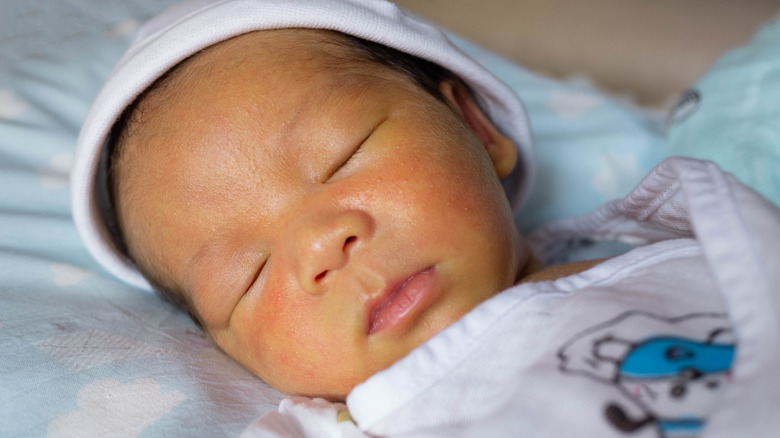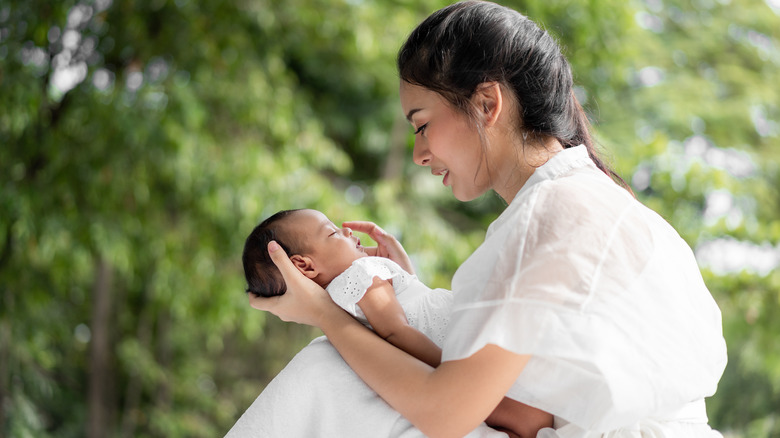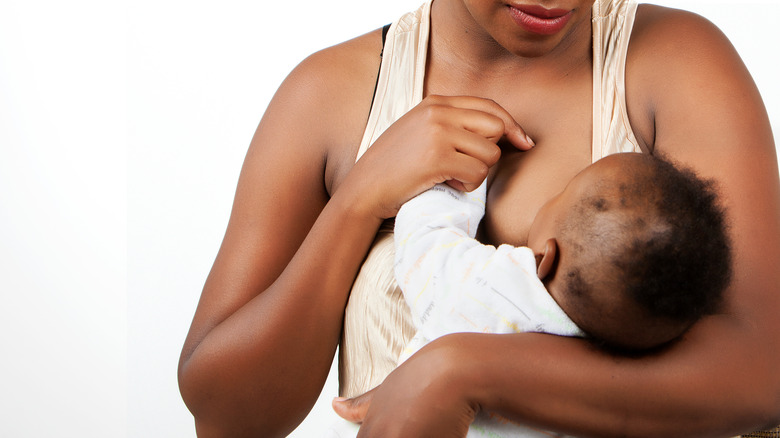How Sunlight Can Help Your Jaundiced Newborn
If your baby is born with a yellow tint to the skin and eyes, there's no need to panic — this is very common and is called infant jaundice, explains the Mayo Clinic. It is simply due to an excess of bilirubin, which is produced when red blood cells end their life cycle and break down (via the Cleveland Clinic). Since bilirubin is filtered through the liver, an immature organ may have more difficulty getting rid of it right away, leading to jaundice. Such may be the case in a baby born prematurely, for example. However, jaundice can affect full-term babies as well. If your baby has this condition, it will show up a couple of days after birth.
While infant jaundice isn't usually concerning and clears up as the baby's liver develops and proper feeding patterns are established, in some cases it can lead to complications that cause brain damage. Specifically, it can cause kernicterus, which the Centers for Disease Control and Prevention (CDC) states is associated with intellectual disabilities, cerebral palsy, and hearing loss, among other issues. For this reason, the American Academy of Pediatrics (AAP) recommends that all care providers measure bilirubin levels in newborns before discharging them after birth.
If a newborn requires immediate treatment for jaundice and is at risk for developing kernicterus, an exchange transfusion can be performed to lower levels of bilirubin (per the AAP). In less severe cases, a baby might be prescribed light therapy.
Filtered sunlight can lower bilirubin levels in the blood
Light treatment, also known as phototherapy, is one way that infant jaundice has been treated, as per the Mayo Clinic. It works by using blue-green spectrum light to target the bilirubin in the bloodstream and alter its makeup in order to help the liver filter it, eventually passing it through the kidneys and into the intestines to be expelled by the body through urine and stool. A baby must be undressed for the treatment to be effective while their eyes are protected with patches.
Researchers took the effectiveness of phototherapy a step further in a 2015 study that was published in The New England Journal of Medicine by utilizing a free resource: the sun. To ensure babies weren't receiving harmful UV rays, researchers placed them underneath specially designed canopies and let the sun treat them for about five hours a day. They found that the filtered sunlight was just as safe and effective for reducing bilirubin levels in the blood as phototherapy.
The Birth Center explains how to use sunlight at home to treat jaundice. You'll want to make sure the baby isn't receiving direct light, but rather filtered light through a window. Lay them on a blanket in just a diaper for about half an hour per day until the yellowing of the skin passes. It's important to note that if the condition doesn't clear up in a few days that you contact your child's medical provider for follow-up testing and treatment.
Alternative treatments for infant jaundice
While phototherapy and filtered sunlight are incredibly effective treatments for infant jaundice, there are a couple other ways to help a newborn get rid of the excess bilirubin in their blood and allow the condition to pass faster. One such method is simply encouraging more feedings through breastmilk or formula, explains WebMD. This helps stool pass through the intestines, which is one of the ways bilirubin is excreted. You'll want to aim for between eight and 12 nursing sessions per 24-hour period, or 1 to 2 ounces of formula every two to three hours if not breastfeeding. Kids Health adds that one of the reasons that infant jaundice develops is due to insufficient breastmilk intake, making it important to ensure that the baby is feeding properly. A lactation consultant can assist with this.
Another treatment method is intravenous immunoglobulin (IVIg), which is only given when a baby and their mother have blood type incompatibilities (per WebMD). Since this incompatibility can cause red blood cells to break down more than normal, the IVIg is used to introduce a protein to prevent this from happening. Finally, there is the exchange transfusion, which is only used in acute jaundice cases and involves giving the newborn a donor blood transfusion while also removing some of their blood.



